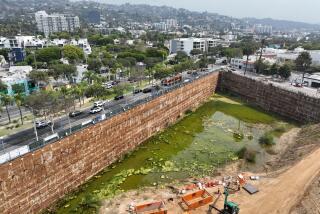Almost Their Waterloo : * Development: For a while, the drought threatened plans for a lake at the Water Garden. Then developers hit on a solution.
- Share via
Drought or no drought, the Water Garden will not be left high and dry. Even before construction started two years ago on the huge office complex at 26th Street and Olympic Boulevard in Santa Monica, the big selling point was to be its 1.4-acre lake.
But as the opening neared, a small problem cropped up: an emergency water conservation regulation enacted by the City Council banning the use of city water to fill decorative fountains and ponds.
And so it was that developer Jerry Snyder and his associates embarked on a search for another source of 500,000 gallons of water.
Santa Monica city officials offered a few ideas:
* Use seawater, they suggested. Too corrosive, the developers concluded.
* Use water from a closed city well that is contaminated with TCE, a suspected carcinogen. No, too expensive to purify.
* Use water from the Pico-Kenter storm drain--the one that feeds into Santa Monica Bay and causes beach closures whenever there’s a storm. No, that would have to be purified, too, and Pico-Kenter has something of an image problem.
* Use reclaimed water from the Donald C. Tillman Water Reclamation Plant in Van Nuys. Reclaimed water is sewage water from which the solid waste has been removed, after which it is filtered and treated with chemicals. At Tillman, the water is treated three times before it is pumped into the Los Angeles River. The treated water is clean enough for irrigation, though not for swimming or drinking.
It wasn’t ideal, Snyder said, but it was the easiest and cheapest source available.
Tanker trucks will begin transporting the water to the lake in the next few days, said Snyder, whose firm, the J. H. Snyder Co., is developing the project in partnership with the Miller/Davis Co.
Snyder said he expects it will take about four days to fill the 18-inch-deep lake. He said he did not yet know how many trucks would be involved, or what the total cost would be. The water itself is quite cheap--94 cents per 1,000 gallons, $470 in all.
The developers could have chosen to fight for city water. Their 1988 development agreement stipulated that 50% of the water used to fill the lake could be city water, with the rest to come from other sources. But, Snyder said, getting into a public dispute for city water during a drought would have created “public relations problems.”
At the Tillman plant, assistant manager Bob Krivak said the drought has produced an increase in inquiries from people interested in purchasing reclaimed water for irrigation and filling of decorative ponds. He said the 500,000-gallon purchase is the largest order so far.
When completed, the Water Garden will be a 1.26-million-square-foot office complex composed of three six-story buildings and one five-story building on a 17-acre parcel.
The complex will have its own on-site sewage treatment plant. Treated water from the plant will be used for irrigation of the landscaping and will be recycled into the lake.
More to Read
Sign up for Essential California
The most important California stories and recommendations in your inbox every morning.
You may occasionally receive promotional content from the Los Angeles Times.













